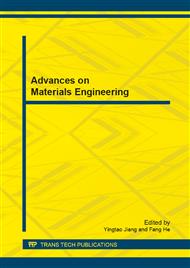p.86
p.92
p.99
p.107
p.112
p.117
p.123
p.128
p.133
Investigations on Low Environmental Impact Machining Processes of Free Cutting Austenitic Stainless Steels
Abstract:
In the present paper, sulfur, RE (rare earth) and bismuth were added to an austenite stainless steel. Low environmental impact machining processes of free cutting austenitic stainless steels was investigated by machinability testing. The results show that a significant amount of grey and dispersed inclusions were found in steel B. The inclusions are typical sulfide inclusions, and bismuth element is attached to double end of manganese sulfide inclusions. Some inclusions exhibit globular shape due to the presence of rare earths elements in steel B. Chip morphology was improved in steel B under the same turning conditions. The machinability of steel B is much better than that of steel A. This is attributed to the presence of free-cutting additives of sulfur, RE and bismuth in the austenitic stainless steels. Satisfactory mechanical properties were also obtained under the conditions of our experiments. The reasons why satisfactory mechanical properties were obtained may lie in that the sulfides and bismuth are soft phase, and the presence of rare earths elements contributes to the improvement of the toughness of the austenitic stainless steels.
Info:
Periodical:
Pages:
112-116
Citation:
Online since:
August 2013
Authors:
Price:
Сopyright:
© 2013 Trans Tech Publications Ltd. All Rights Reserved
Share:
Citation:


